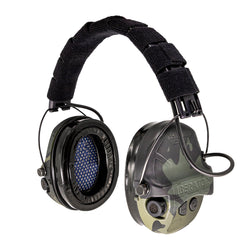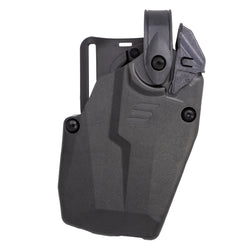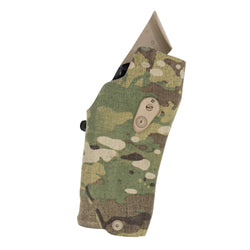As a 28+ year veteran police officer who had the sobering experience of literally fighting for my pistol outside of its holster, the topic of firearm retention is, needless to say, near and dear to my heart.
When I see an officer walking around with their retention defeated, or watch them defeat it without drawing their pistol (especially if it stays defeated), I get the urge to say something. The same goes for the officers, detectives, and federal agents that I see carrying with single or no retention.
I stopped speaking up to individual officers and agents because I was consistently met with uneducated pushback: “I won’t be able to draw fast enough!” or “I’ve practiced drawing fast, and I fumble the retention.” In the case of patrol officers, preemptively defeating their retention often happens during traffic stops.
What I wish I could do is replicate the intense fear and adrenaline dump I felt during the incident where I fought for my gun and inject it into them during the conversation. I almost drowned as a kid — literally at the bottom of a pool, going from extreme panic to accepting my perceived fate — until my friend’s mom ran from 100 yards away and dove in to save me. That was the same horrible feeling I experienced during the fight for my firearm.
If you’re someone who walks around with your retention defeated, or even defeats it on a traffic stop, stop and imagine that feeling: another person’s hand on your gun, literally fighting for your life. Imagine how it could end and how it would feel if your family received that knock on the door. Now ask yourself if you would continue to neglect proper retention after that.
You don’t know what you don’t know
Some of this is the old, “You don’t know what you don’t know.” Some of it is “institutional inbreeding.” I was taught it by someone with good intentions and legitimate concerns themselves, so I believe it to be not only the truth, but THE ONE TRUTH.

I can say this because I was taught something similar as a young NYPD Officer. Back then, the NYPD issued the double-retention Safariland 295 holster. I was issued this holster in several other agencies that I worked for later in my career, as well. At the time, my shooting skills weren’t what they are today. Years later, I learned to achieve a fast, sub-second draw with that holster and realized it was very doable — but not back then.
In 1997, while at the NYPD academy, the firearms instructors at the outdoor range at Rodman’s Neck in the Bronx routinely demonstrated how easy it was to take our guns from our duty holster quickly and efficiently, even with both levels of retention engaged.
At the time, the Safariland 295 was considered advanced compared to the old thumb-snap retention holsters, but it was nowhere near the duty standard or level of retention found in modern Safariland duty holsters. It was also well known at the time that the notorious Latin Kings put a $1,000 bounty on any cop’s 15-round magazine (because of the NY magazine restrictions), and members would receive a promotion in the organization if they successfully stole a cop’s gun.
Despite knowing all of this, we would still defeat both levels of retention on our Safariland 295 while keeping the gun in the holster and hand on the gun, or remove the gun from the holster and keep it down by our side on traffic stops. Some officers even approached vehicles with their hand on a backup gun carried in a jacket pocket, with no holster or retention at all.
Train and keep your hand on your gun

Obviously, action is faster than reaction. Drawing from retention to a first-round hit at speed only takes a little skill, but most cops will never get the proper initial and sustainment training to know that. This is why you need to seek out training outside of work.
Yes, you can fumble a draw—I’ve done it plenty of times on the range. But in over 28.5 years on the street, drawing under stress countless times, I’ve never fumbled once. There are times your gun should be out and at the ready, but a routine traffic stop isn’t one of them. What I will say is that your hand should be on your gun, thumb on the retention when approaching or reapproaching a car on a traffic stop. Too few cops practice this, yet it can save a quarter second or more. It’s also smart if someone inside starts digging in the armrest, under the seat, or into the glove compartment.
It wasn’t until I went to an officer survival school during my first year on the job that I was asked a question: Are you more likely to go hands on with a suspect or shoot them? Obviously the answer is hands on. Which is why all your retention needs to be in place. In fact, there’s a 2016 report of an NYPD officer having his gun taken by a suspect (ABC7 report). Around that time, the NYPD transitioned to the Safariland 6360 triple-retention holster to address that very risk.
Outside carriers defeating retention and impeding your draw

With the popularity of outside soft body armor carriers, two things need to be kept in mind when setting up an outside carrier: the ability to draw your pistol and weapon retention.
The first step is to keep the handgun side of your vest clear. Do not attach pouches and gear to the vest that could impede your draw, especially when seated.
Second, adjust your seat or use a Cantable Belt Loop (CUBL) or a Vertical Belt Loop (VUBL), and position your pistol so you can draw quickly and efficiently without the vest defeating your retention while seated. If policy prohibits those attachments, make checking that your retention is engaged second nature—do it constantly.
Your silence and their attitude can cost you
When I finished up my time in the field training unit (FTU) of the 47 PCT in The Bronx, I went to the 4-12 shift. I didn’t have a partner initially, and one night I got paired up with the one guy nobody wanted to work with and everyone got stuck with eventually.
During the shift, we stopped a guy at gunpoint who matched the description of a robbery suspect. I took the cover position while my partner cuffed and searched him. As he made contact, he holstered his gun but left the retention defeated, with the gun rocked forward. You didn’t need to be a cop or a gun guy to see that was a problem. I said something to him as he went hands-on with the perp. His response? “Pffft. That will be the day that someone gets Officer Smith’s gun.”
Yes, he talked about himself in the third person—and yes, he thought he was invincible. Speaking up wasn’t just for his own good; my safety depended on his weapon retention, too.
Take a look at the NYPD body camera video, shared to the Police Activity YouTube channel. If you slow it down at 4:45, you can see the officer’s SLS is defeated. A struggle ensues, and the suspect gets his gun. The cop yells, “He got my gun!” Cops get shot as well as the suspect. This most likely could have been prevented by having his SLS engaged.
Selecting the right level of retention
Unfortunately, we live in a social‑media world where firearm retention isn’t sexy, but the sub‑second draws on “the gram” are. The reality is that most cops and most shooters will never achieve a true sub‑second draw, even with no retention. I remember watching a breakdown on the Active Self Protection YouTube channel: his analysis showed the average draw time for the first shot in a gunfight is about 1.5 seconds. That is very doable with a Level 3 retention holster. Would it be nice to have a sub-second draw? Sure, but not while sacrificing retention.
A lot of instructors on social media, even those teaching LE/Mil clients, use single‑retention or no‑retention holsters. That lets them show off sub‑second times with practice, but it sacrifices retention.
I’ve never seen a gun grab on the range, yet I’ve referenced three that happened on the street in this article alone. The second‑ and third‑order effects of online training are showing up in the field: people move to single‑retention holsters for SWAT, detective, or admin work, then carry single‑retention on patrol and no‑retention for plainclothes work. It doesn’t have to be this way. If you have a say in your duty holster, get a Level 3 and learn how to get a sub-1.5-second draw.
Lead by example
If you are an instructor teaching LE/Mil, teach with a Level 3 holster and a stock duty-type gun. I recently taught a free police pistol class and brought in a friend to help. He didn’t own a triple‑retention holster, so I got one for him to use in the class. What showed up? A single‑retention holster — which he then modified into a race gun.
If you are an instructor, you need to run guns and gear similar to your clients. If not, they will chase the gear, thinking that is how you do it, and this cycle will never end. Leave your ego at the door. Choose the right level of retention for your duty holster or the holster you teach LE/Mil with, and set the right example. Lives depend on it.









